The Mental-Health Status and Mental Disorders of Residents Living in Urban and Industrial Areas in Thailand and South Korea
Keywords:
Mental health and mental disorders, Urban and industrial areas, Thailand, South KoreaAbstract
Background: Regarding the economic and social development of South Korea, it has caused rapid and tremendous change, including development of large-scale industry, expansion of cities, and demographic changes, especially the migration of the working-age population from
rural to urban and industrial areas. The lifestyle of the Korean people has changed from a rural style to an urban lifestyle, resulting in the necessity to adapt quickly to the new society, and this may have unavoidably led to mental disorders (MDs) and suicide. It was found that the suicide rate in South Korea was the highest among the countries that are members of the Organization for Economic Cooperation and Development. In Thailand, the economic and social development was planned at the same time as in South Korea. However, the suicide rate of Thais was lower than the suicide rate of South Koreans, and the trend of the suicide rate of Thais has also been rather constant. It is hoped that the lesson learned from South Korea can be useful for Thailand regarding its preparedness to develop its urban and industrial areas. Therefore, the comparative analyses of the literature, reviews of existing policy, and overviews of previous research were used to generate a synthesis of the existing knowledge of mental health status (MHS) and mental disorder-related issues in Thailand and South Korea.
Objective: The objective of this preliminary study was to compare the similarities and differences of the MHS and MDs of residents living in the urban and industrial areas of Thailand and South Korea.
Result: It was found that the key factors affecting the MHS and MDs of the people in Thailand and South Korea were education, family income, length of stay in urban and industrial areas, and the causes of stress derived from the physical, psychological, and socio-cultural environment.
Discussion and Conclusion: 1) Education played an important role in the understanding of communities. Education was a tool for encouraging people both in Thailand and South Korea to have better mental health and to adjust their living with wellness and happiness; 2) Family income was also seen an important factor affecting the MHS of people. Although today South Korea has been able to recover its economy rapidly, MDs, especially the suicide rate in South Korea, have continued to increase when compared with Thailand; 3) Length of stay in urban and industrial areas was considered as a change in housing areas and social activities, and it represented a change of life for Thais and South Koreans, especially change from rural to industrial areas; and 4) Regarding the causes of stress derived from the physical, psychological, and socio-cultural environment, an issue frequently found in urban and industrial areas of both countries was the toxicity of the environment, which has caused adverse effects on physical and psychological stress. In addition to social determinants, urbanization and industrialization have changed their people’s life styles, i.e., technology consumption, alcohol use, etc. This socio-cultural environment has been prone to forming psychosis and neurosis easily, finally impacting MHS and MDs.



